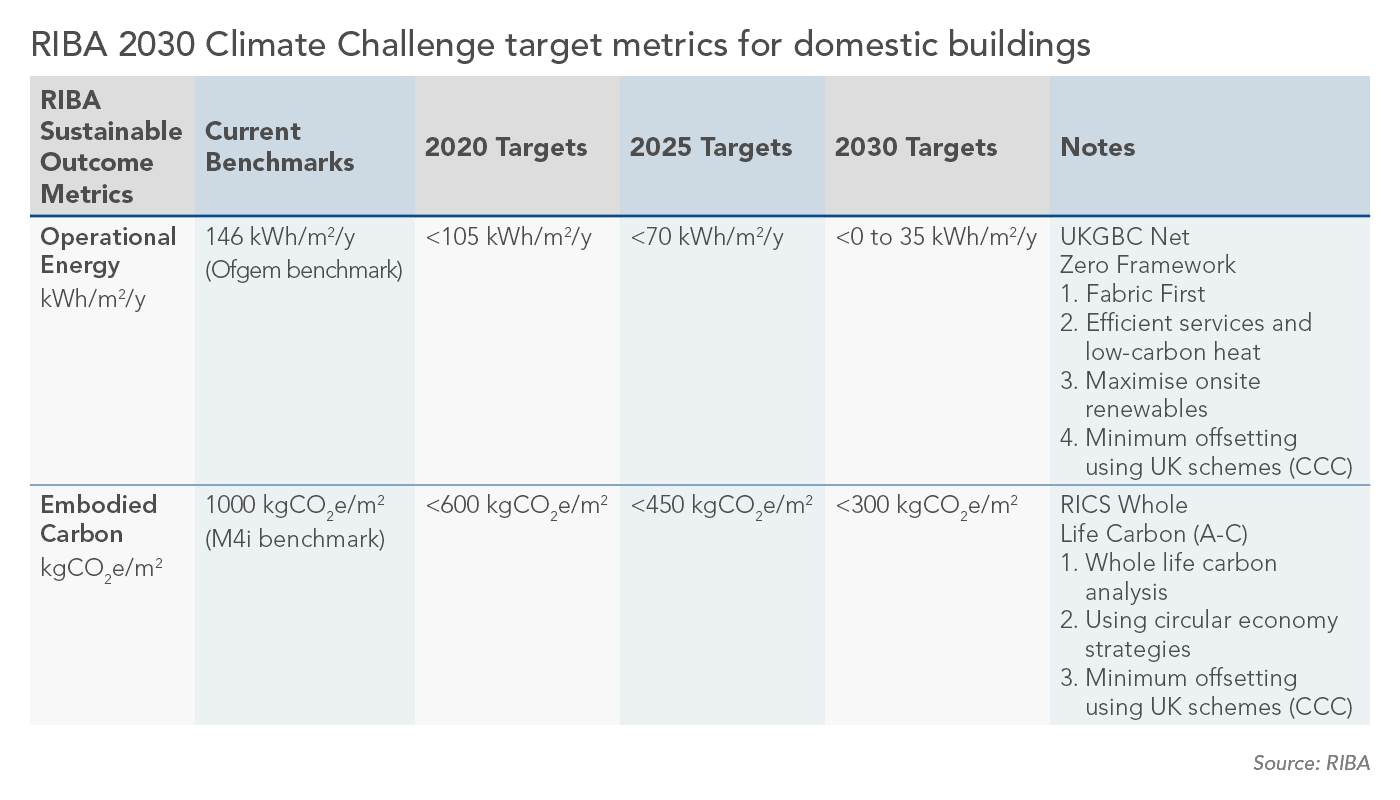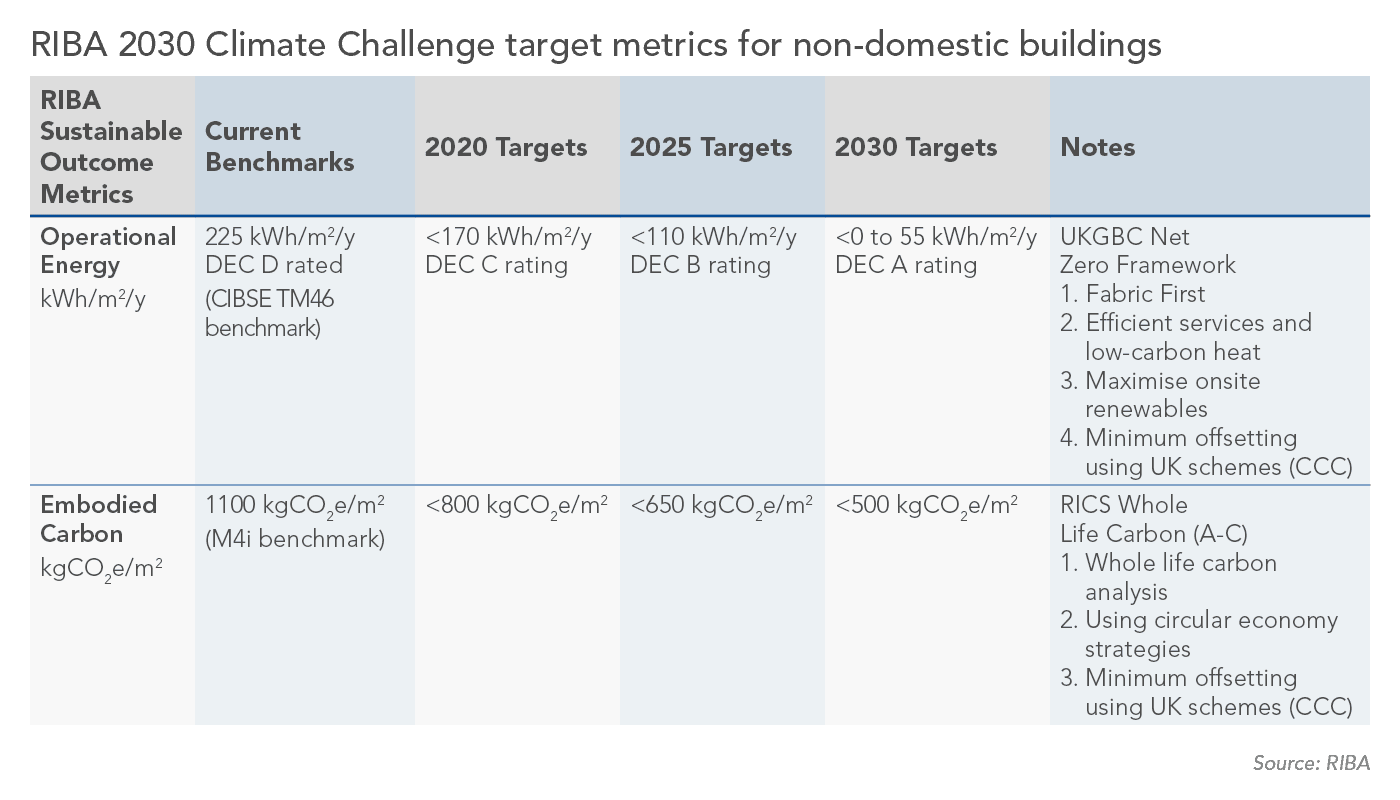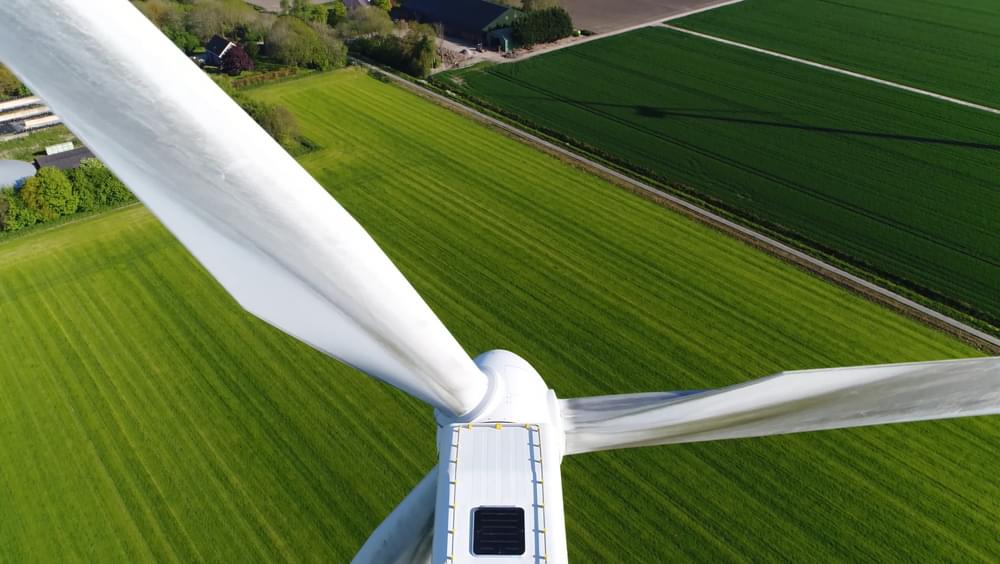As the construction industry makes the transition towards net zero carbon emissions, there is a growing body of guidance and performance targets to help improve the sector’s collective understanding on how to design and deliver low carbon buildings. The industry is becoming increasingly aware of the level of building performance that will be required to achieve a net zero carbon outcome. But for net zero carbon buildings to be delivered at scale and theoretical targets to be achieved in practice, structural market transformation is necessary. In the first of a series of articles on low carbon buildings, we examine some of the targets and benchmarks that have been set and what the implications of meeting these might be.
Introduction
The Oxford Dictionary chose ‘climate emergency’ as the word of the year in 2019. Usage of the term soared by more than 10,796% between September 2018 and September 2019[1] and in the same year, more than 11,000 scientists signed an article published in the journal BioScience[2], declaring “clearly and unequivocally that planet Earth is facing a climate emergency.”
According to Oxford Dictionaries, ‘climate emergency’ is defined as “a situation in which urgent action is required to reduce or halt climate change and avoid potentially irreversible environmental damage resulting from it”[3]. The word has climbed from relative obscurity to becoming one of the most prominent terms in recent years. Hundreds of cities and even some countries have declared “climate emergencies” in the past couple of years in an attempt to convey the gravity of the situation[4].
Net Zero Carbon
In response to the declared climate emergency, the UK signed into law a ground-breaking target of hitting net zero-carbon emissions by 2050.
The UK was one of the first countries to enshrine in law a net zero target for greenhouse gas emissions. The statutory target was set by the Climate Change Act 2008 and it aims for at least a 100% reduction of UK greenhouse emissions by 2050 (compared to 1990 levels). It is known as a net zero target because some emissions can remain if they are offset (ie by removal from the atmosphere through various schemes and/or by trading in carbon units).
The National Grid suggests that we can think about net zero like a bath – turn on the taps and you add more water, pull out the plug and water flows out. The amount of water in the bath depends on both the input from the taps and the output via the plughole. To keep the amount of water in the bath at the same level, you need to make sure that the input and output are balanced[5].
Reaching net zero carbon applies the same principle, requiring us to balance the amount of greenhouse gases we emit with the amount we remove. Under net zero, the greenhouse gasses that we add to the atmosphere are equal to what we take away or remove. If met, this target would effectively mean the UK would end its contribution to global emissions by 2050.
Although achieving ‘gross zero’ (ie stopping all carbon emissions) would be ideal, this isn’t realistically attainable across all sectors and industries. Some emissions in certain sectors will be unavoidable. Net zero, however, looks at emissions overall and allows us to remove unavoidable carbon emissions via nature (eg planting more trees that take carbon dioxide from the atmosphere), new technologies and improved industrial processes.
Construction and Carbon
Construction has a hugely important role to play in achieving net zero. Buildings and the construction sector are responsible for 39% of annual global carbon emissions[6], which primarily comes from ‘operational emissions’ and ‘embodied emissions’.
Operational emissions – ie emissions from the energy used to heat, cool and light buildings on an annual basis – account for 28% of all carbon emissions in the world. The remaining 11% comes from embodied carbon – ie carbon emissions associated with materials and construction processes used throughout the whole building lifecycle[7].
The recent Green Construction Board Buildings Mission 2030 report[8] demonstrates that reducing energy consumption in all new buildings by at least 50% (compared to the average equivalent building) by 2030 is technically and financially feasible now. However, for this to be widespread it will require “significant upskilling and a change of culture across the industry” and necessitate the use of new techniques and technologies according to report.
Net zero operational carbon buildings are evidently possible but there are currently very few large-scale buildings in the UK that have achieved this status. Although an in-depth analysis of operational carbon is beyond the scope of this paper, for a building to be net zero operational carbon, either all outstanding energy use must come from renewable sources or the National Grid must be fully decarbonised – something that is not expected to happen until 2050. However, in order to meet our climate change targets, all new buildings must operate at net zero by 2030. According to the UK Green Building Council (UKGBC), this effectively means that by 2025 all new buildings will have to be designed to meet the target of net zero operational energy[9].
Although the energy used in the operation of buildings represents the most significant carbon impact (contributing 30% of the UK’s total emissions in 2017), operational emissions are only part of the story. At an individual building level, embodied carbon emissions from construction in a new building can account for up to half of the carbon impacts associated with the building over its lifecycle[10]. Consequently, close attention needs to be paid to embodied carbon in construction if the UK is to meet its 2050 net zero target.
The World Green Building Council (WGBC) report ‘Bringing embodied carbon upfront’ shows how we can reach 40% less embodied carbon emissions by 2030 in all new buildings, infrastructure and renovations. By 2050, the WGBC’s vision is that 100% of new buildings, infrastructure and renovations will have net zero embodied carbon and that all buildings (including existing buildings) must be net zero operational carbon[11].
To achieve these goals, the WGBC report calls for co-ordinated solutions and immediate action by the entire building and construction value chain. Changes need to be made to the way we design, build, use and deconstruct our buildings. In short, a radical shift is needed to enable global market transformation.
Government policy will play a pivotal role in facilitating the shift. France, for example, recently announced plans for a sustainability law that would ensure that all new public buildings are built from at least 50% timber or other bio-based materials (eg hemp and straw) that have a significantly lower embodied carbon footprint compared to concrete and steel. It will be implemented in 2022 and will affect all public buildings financed by the state[12]. These policy changes will increase the build-out of sustainable, low-carbon structures.
According to the UKGBC, the built environment was responsible for around 42% of the UK’s total carbon footprint in 2014, although almost half of this was from energy used in buildings and infrastructure (ie ‘in use’ energy) that had nothing to do with their functional operation[13]. According to some reports, around 10% of the UK’s carbon emissions are directly associated with construction activities[14]. The Royal Institute of British Architects (RIBA) has acknowledged the part that architects need to play in reducing the UK’s carbon emissions from construction. In June 2019, RIBA voted to join the global declaration of the environment and climate emergency and has since developed its 2030 Climate Challenge to help architects meet net zero (or better) whole life carbon[15] for new and retrofitted buildings by 2030[16].
Designing for Net Zero Carbon
The RIBA 2030 Climate Challenge sets a series of targets for practices and the wider construction industry to adopt in order to reduce operational and embodied carbon. The progressive targets (explored in more detail below) have been developed in consultation with other UK professional bodies and have been designed to help the construction industry deliver the necessary carbon reductions by 2030 so that the industry has a realistic prospect of achieving net zero carbon for the whole of the UK building stock by 2050.
In order to achieve a ‘carbon neutral’ built environment by 2050 (ie achieving net zero carbon emissions by balancing carbon emissions with removal or simply eliminating carbon emissions altogether), it is imperative that we adopt carbon neutral design. Carbon neutral design is a subset of sustainable design. There is carbon involved in the extraction of the resources used to create materials and products, in the transportation of these products to site, in the physical construction of the buildings, in the operation of buildings and in the lives of people as they carry on business. If we take a holistic approach (in line with the aims of the Paris Climate Agreement) and factor in carbon emissions at each stage of the process, the calculations become very difficult. In practice, a holistic approach would be difficult to deliver today due to the lack of accurate emissions data, but this is what the RIBA targets aim for.
The RIBA 2030 Climate Challenge targets focus on ‘whole life’ net zero carbon emissions based on the definition outlined in the UKGBC’s Net Zero Framework[17]. Although the UKGBC’s Framework provides a definition of ‘whole life’ net zero carbon, it currently suggests that developers use the following two approaches to net zero carbon – neither of which incorporate net zero whole life carbon:
1. Net zero carbon – construction (for new buildings and major renovations)
"When the amount of carbon emmisons associated with a bulding's product and construction stages up to practical completion is zero or negative, through the use of offsets or the net export of on-site renewable energy."
2. Net zero carbon – operational energy (for all buildings in operation)
"When the amount of carbon emissions associated with the building's operational energy on an annual basis is zero or negative. A net zero carbon building is highly energy efficient and powered from on-site and/or off-site renewable energy sources, with any remaining carbon balance offset."
Achieving net zero carbon under 1.1 (construction) and 1.2 (operational energy) represents the greatest level of commitment to the framework, and this is what buildings are encouraged to aim for. Although a third approach (1.3) for ‘net zero carbon – whole life’ has been proposed at a high level, further work will be needed to define the scope and requirements for this approach.
Net zero whole life carbon (1.3) is not proposed as an approach by the UKGBC at present due to current limitations in the collection, reporting and verification of carbon emissions data from the maintenance, repair, refurbishment and end-of-life stages of a building’s lifecycle. The lack of reliable data for these stages (which are needed for a true ‘whole life’ carbon assessment) would mean that emissions would be modelled on estimates alone. However, UKGBC’s Net Zero Framework does give an indicative timeline for framework development which suggests that a ‘net zero carbon – whole life approach’ could be developed by the end of 2021. Indeed the Greater London Authority (GLA) has produced draft guidance containing information on how to prepare an assessment of carbon emissions to fully capture a development’s whole life carbon impact. The guidance will apply to planning applications referred to the Mayor of London, however the assessment is encouraged for all major applications. The assessment template will provide benchmarking data that will inform future policy and whole life carbon methodology.
Whilst our understanding of the whole life carbon impact grows and the UK moves closer towards a net zero whole life carbon approach, the RIBA has set its Chartered Practices the challenge of achieving the following reductions (compared to the relevant current benchmarks) as soon as possible:
- Reduce operational energy demand by at least 75%, before UK offsetting
- Reduce whole life embodied carbon by at least 50-70%, before UK offsetting
For both operational and embodied carbon, RIBA has set specific reduction targets for 2020, 2025 and then 2030 for both commercial and domestic buildings based on current benchmarks. However, it’s worth noting that RIBA’s yearly targets are a little unclear in terms of what the year marks. For example, is 2030 the year of practical completion/operation or design? If the former, then we should already be hitting the 2025 targets, or even 2030 targets for larger, more complex projects.
While RIBA acknowledges that these metrics may develop over time, it suggests that the industry cannot wait for the perfect benchmarks to be developed. According to the RIBA, reaching these incremental targets will give the construction industry a realistic prospect of achieving net zero carbon for the whole UK building stock by 2050.


Although a ‘whole life’ approach to carbon is difficult today and produces a greater range of uncertainty, the RIBA does still recommend using the RICS’ Whole Life Carbon Assessment for the Built Environment professional statement 2017[18] when calculating embodied carbon. It suggests using categories A-C of the Statement which incorporate the product, construction process, use and end of life stages (ie ‘cradle to grave’).
This goes beyond the scope of the UKGBC’s recommendation of calculating embodied carbon from ‘cradle to practical completion’ during the building’s product and construction stages – also a fairly difficult task as it only eliminates a few of the unknowns from the equation[19].
‘Offsetting’ forms part of both definitions for net zero carbon (1.1 – construction and 1.2 operational energy) under the UKGBC’s Framework. This means that if there is any remaining carbon, it can be offset to achieve a net zero carbon balance. Offsetting (which is undertaken based on measured data at the point of practical completion for buildings aiming to achieve net zero carbon for ‘construction’) can be done using two routes:
- One-off payment made at the point of completion and/or
- Net export of on-site renewable energy on an annual basis
As the final step to achieving a net zero carbon building, offsetting can be used to cover any residual carbon when all feasible methods for reducing carbon impacts have been ‘reasonably exhausted’ - a description which has not yet been defined by the UKGBC. The UKGBC’s technical requirements for offsetting stipulate that offsets should either be procured directly or via recognised existing offsetting frameworks such as the Clean Development Mechanism[20] and Gold Standard[21].
Concerns have been raised by the industry regarding the reliability of carbon abatement through offsets and the UKGBC appears to be planning to phase out the use of offsets for operational energy. This would mean that all operational energy demand will need to be met using renewable energy. The UKGBC also suggests setting a maximum threshold for offsets or preventing the use of offsets for new buildings and it’s likely that subsequent frameworks will set out a plan for phasing out offsets over time. If we are to realise a net zero carbon built environment in the future then offsets will need to be phased out as far as possible.
[1] https://www.earthday.org/clima...
[2] https://academic.oup.com/biosc...
[3] https://www.oxfordlearnersdict...
[4] https://www.theguardian.com/en...
[5] https://www.nationalgrid.com/s...
[6] https://www.worldgbc.org/news-....
[7] https://www.worldgbc.org/news-....
[8] http://www.constructionleaders...
[9] https://www.ukgbc.org/ukgbc-wo...
[10] https://www.ukgbc.org/ukgbc-wo...
[11] https://www.worldgbc.org/bring...
[12] https://www.globalconstruction...
[13] https://www.ukgbc.org/climate-....
[14] https://www.builders.org.uk/nf...
[15] Whole life carbon refers to lifecycle stages/ modules A-C under European Standard EN 15978. Although the definition is still being developed to take account of all building lifecycle stages, net zero whole life carbon has been defined by the UKGBC as “When the amount of carbon emissions associated with a building’s embodied and operational impacts over the life of the building, including its disposal, are zero or negative.”
[16] https://www.architecture.com/a...
[17] https://www.ukgbc.org/ukgbc-wo...
[18] https://www.rics.org/uk/uphold...
[19] A building’s product and construction stages are defined as modules A1 to A5 of EN15978 (‘embodied carbon to practical completion’ as per Section 1 of the RICS Professional Statement).
[20] United Nations Framework Convention on Climate Change (UNFCCC) (2019). Clean Development Mechanism. [online] Available at: http://cdm.unfccc.int/ [Accessed 01/04/2019].
[21] Gold Standard for the Global Goals. Available at: https://www.goldstandard.org/




